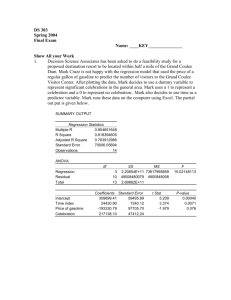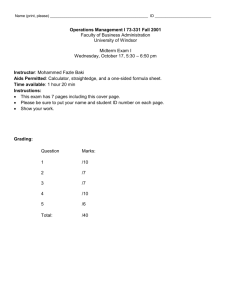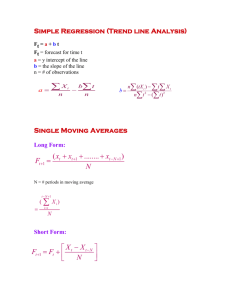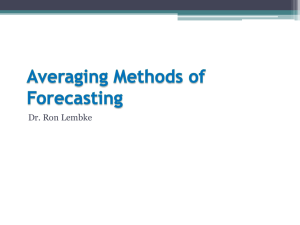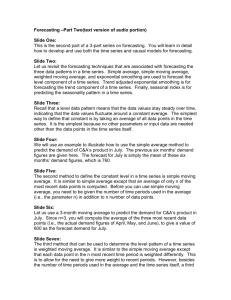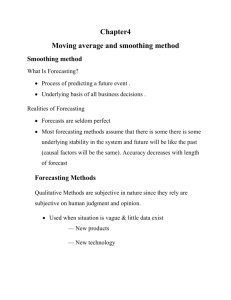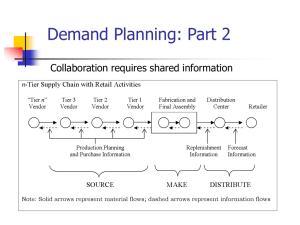Which method uses an arithmetic mean to forecast the next period
advertisement
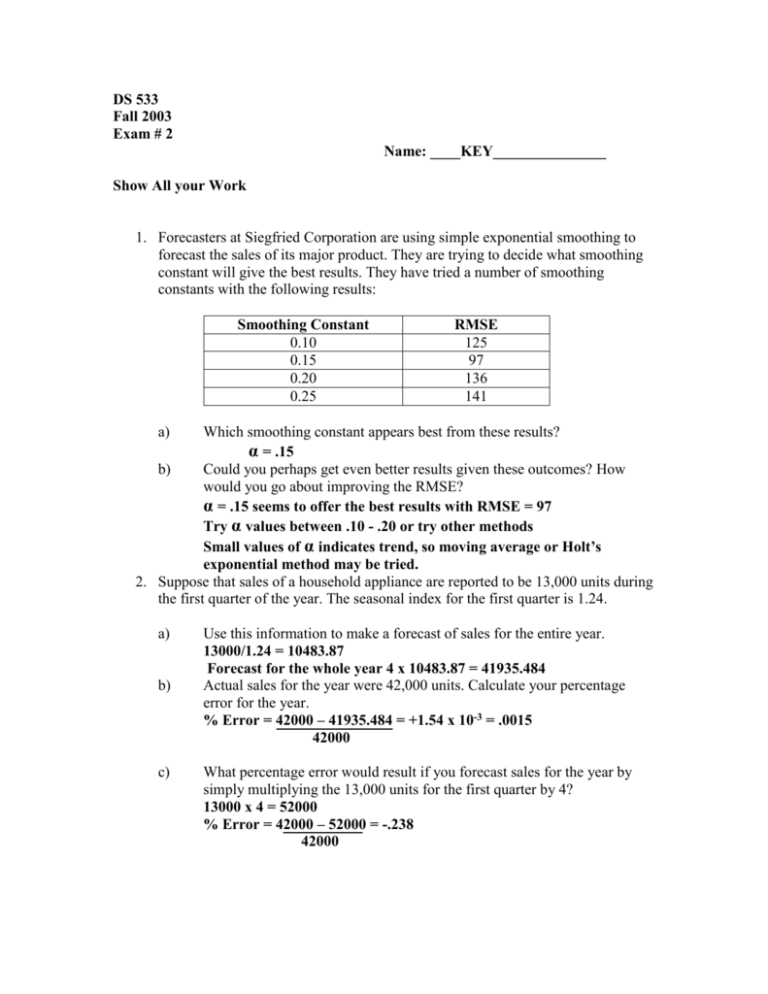
DS 533 Fall 2003 Exam # 2 Name: ____KEY_______________ Show All your Work 1. Forecasters at Siegfried Corporation are using simple exponential smoothing to forecast the sales of its major product. They are trying to decide what smoothing constant will give the best results. They have tried a number of smoothing constants with the following results: Smoothing Constant 0.10 0.15 0.20 0.25 RMSE 125 97 136 141 a) Which smoothing constant appears best from these results? α = .15 b) Could you perhaps get even better results given these outcomes? How would you go about improving the RMSE? α = .15 seems to offer the best results with RMSE = 97 Try α values between .10 - .20 or try other methods Small values of α indicates trend, so moving average or Holt’s exponential method may be tried. 2. Suppose that sales of a household appliance are reported to be 13,000 units during the first quarter of the year. The seasonal index for the first quarter is 1.24. a) b) c) Use this information to make a forecast of sales for the entire year. 13000/1.24 = 10483.87 Forecast for the whole year 4 x 10483.87 = 41935.484 Actual sales for the year were 42,000 units. Calculate your percentage error for the year. % Error = 42000 – 41935.484 = +1.54 x 10-3 = .0015 42000 What percentage error would result if you forecast sales for the year by simply multiplying the 13,000 units for the first quarter by 4? 13000 x 4 = 52000 % Error = 42000 – 52000 = -.238 42000 3. The data in the table below give quarterly sales of the popular game Oligopoly at the J-Mart variety store. Year 1 Quarter 1 2 3 4 1 2 3 4 1 2 3 4 2 3 Time 1 2 3 4 5 6 7 8 9 10 11 12 a) Find a four period moving average for each quarter. b) Find the centered moving averages for the sample. c) Find the seasonal factors. Report your results in the following table Year Quarter Time Oligopoly Sales 1 1 2 3 4 1 2 3 4 1 2 3 4 1 2 3 4 5 6 7 8 9 10 11 12 20 25 35 44 28 29 43 48 24 37 39 56 2 3 Oligopoly Sales 20 25 35 44 28 29 43 48 24 37 39 56 MA CMA SF 31 33 34 36 37.25 36 38 37 39 32 33.5 35 36.625 36.625 37 37.5 38 1.09 1.31 .8 .79 1.17 1.29 .64 .97 d) Consider using the multiplicative decomposition method to forecast Oligopoly sales for year 4 given the following information: a. The centered moving average trend (CMAT) is estimated as CMAT=24.1+1.8(time) b. The seasonal index (SI) and cyclic factor (CF) are given below: Year Quarter Time Oligopoly Sales 1 1 2 3 4 1 2 3 4 1 2 3 4 1 2 3 4 1 2 3 4 5 6 7 8 9 10 11 12 13 14 15 16 20 25 35 44 28 29 43 48 24 37 39 56 2 3 4 e) CMAT SI CF 47.5 49.3 51.1 52.9 0.71 0.87 1.12 1.29 0.71 0.87 1.12 1.29 0.71 0.87 1.12 1.29 0.71 0.87 1.12 1.29 1.08 1.07 1.06 1.05 0.99 0.96 0.93 0.90 1.01 1.00 0.98 0.93 0.90 1.00 Given the actual values shown in the following table, calculate the root mean squared error (RMSE) for the year 4. Period Year 4 Q1 Year 4 Q2 Year 4 Q3 Year 4 Q4 Oligopoly sales Actual Forecast 30 33.0505 36 39.8886 39 51.5088 65 68.241 Sum of Squared Errors = 191.4010 Mean squared Error = 47.85 Root Mean Squared Error = 6.917 Squared Error 9.3056 15.1212 156.4701 10.5041 4. Public sector economists routinely require unemployment forecasts in budget planning and revenue projections. Consider the following time-series plot of the U.S. unemployment rate over the period 1980M1-1997M4: Given the graph above, which smoothing model(s) may be the most appropriate? What factors may explain this? As the data shows appreciable trend and no pronounced seasonality, candidate models are moving averages, simple exponential smoothing. Multiple Choice Questions Select the best Answer 1. Which method uses an arithmetic mean to forecast the next period? A) B) C) D) 2. Which method is used to develop a simple model that assumes that weighted averages of recent periods are the best predictors of the future? A) B) C) D) E) 3. Naive. Moving averages. Exponential smoothing. None of the above Naive. Moving averages. Exponential smoothing. Naïve model squared. None of the above Simple-exponential smoothing models are useful for data, which have A) B) C) D) E) a downward trend. an upward trend. neither an upward or downward trend. pronounced seasonality. All the above. Note: The next three questions relate to the following data: Actual Series 100 110 115 Time Period 1 2 3 4. Forecast Series 100 --- Forecast Error 0 --- If a smoothing constant of .3 is used, what is the exponentially smoothed forecast for period 4? A) B) C) D) E) 106.6. 103.0. 115.0. 112.6. 104.4. 5. What is the forecast error for period 3? A) B) C) D) E) 6. If a three-month moving-average model is used, what is the forecast for period 4? A) B) C) D) E) 7. -3. -12. -10. -7. +7. 104.4. 106.6. 107.1. 108.3. 110.2. Holt's smoothing is best applied to data that are A) B) C) D) E) nonseasonal. nonstationary. deseasonalized with a trend. nonstationary and nonseasonal. All the above. 8. How many first initial values must the forecaster set using Winter's exponential smoothing? A) B) C) D) E) 9. 0. 1. 2. 3. None of the above. Which of the following is not a component in the time series decomposition model? A) B) C) D) E) Trend. Seasonal variation. Irregular variation. Business indicators. Cyclical variation. 10. 11. When calculating centered moving-averages using a 4-period moving average, how many data points are lost at the beginning of the original series? A) 1. B) 2. C) 3. D) 4. E) None of the above. A seasonal index number of .80 for quarter one of an automobile parts manufacturer suggests A) B) C) D) E) 12. Quarter one sales are 80% above the yearly norm. Quarter one sales are 1.80% below the yearly norm. Quarter one sales are 20% below the yearly norm. Quarter one sales are 80% below the yearly norm. None of the above. The sum of seasonal index numbers for monthly data should equal A) B) C) D) E) one. sample size/2. 4. 12. None of the above. Formulas Moving average Exponential Smoothing ( yt yt 1 yt 2 yt k 1 ) K Holt’s method yˆt 1 yt (1 ) yˆ t yˆ t 1 yˆ t 1 yˆ t ( yt yˆ t ) Tt ( Lt Lt 1 ) (1 )Tt 1 Lt yt (1 )( Lt 1 Tt 1 ) yˆ t p Lt pTt Winter’s method Lt yt (1 )( Lt 1 Tt 1 ) St p St Tt ( Lt Lt 1 ) (1 )Tt 1 yt (1 ) St p Lt yˆ t m ( Lt mTt ) St m p Decomposition method Yt Tt Ct St I t SFt Yt CMAt Yt Tt Ct St I t CF CMA CMAT CMAT a b(Time) Errors MAE 1 n yt yˆ t n t 1 MSE 1 n ( yt yˆ t ) 2 n t 1 MAPE MPE n RMSE (y t 1 t yˆ t ) 2 n 1 n y t yˆ t y n t 1 t 1 n ( yt yˆ t ) y n t 1 t

